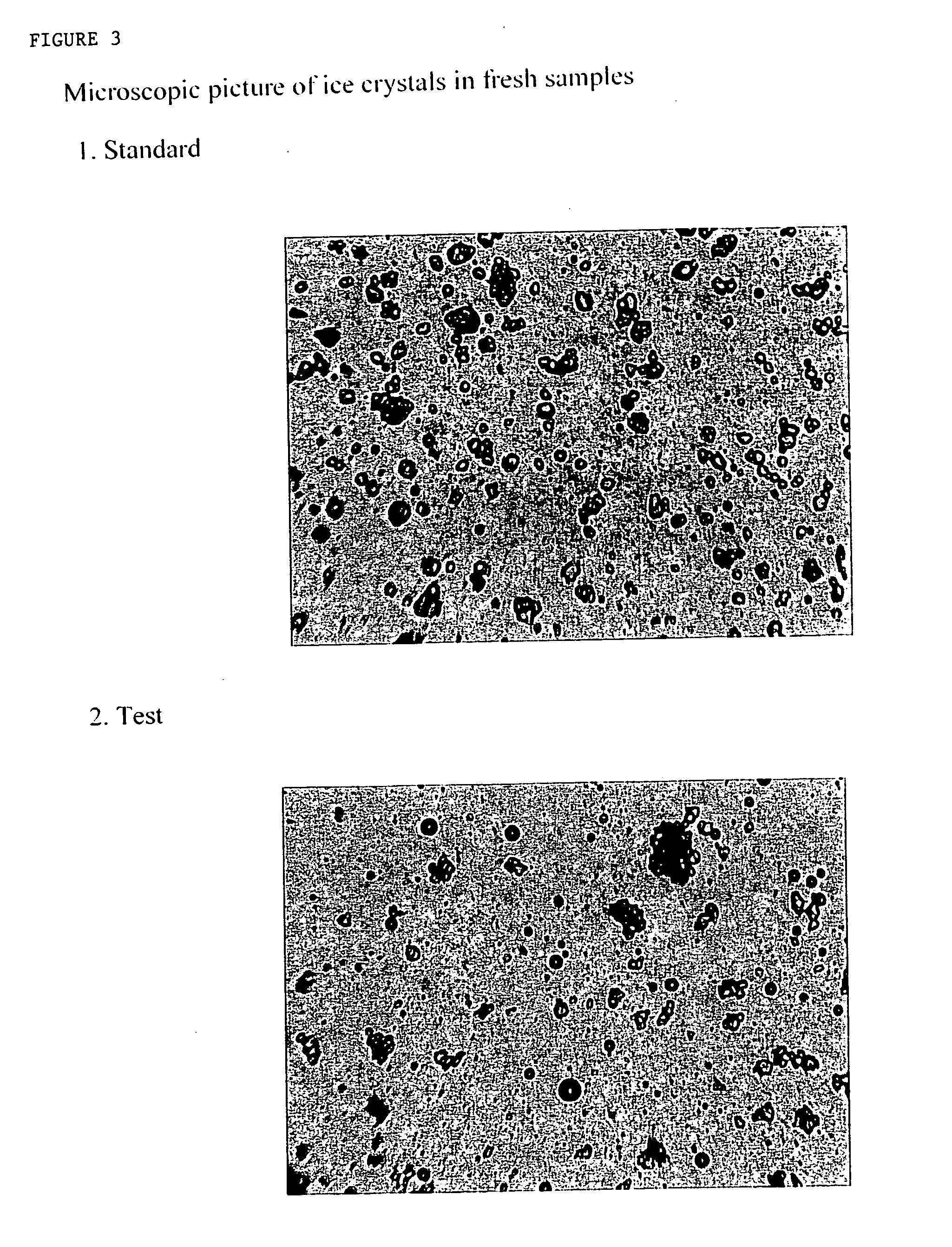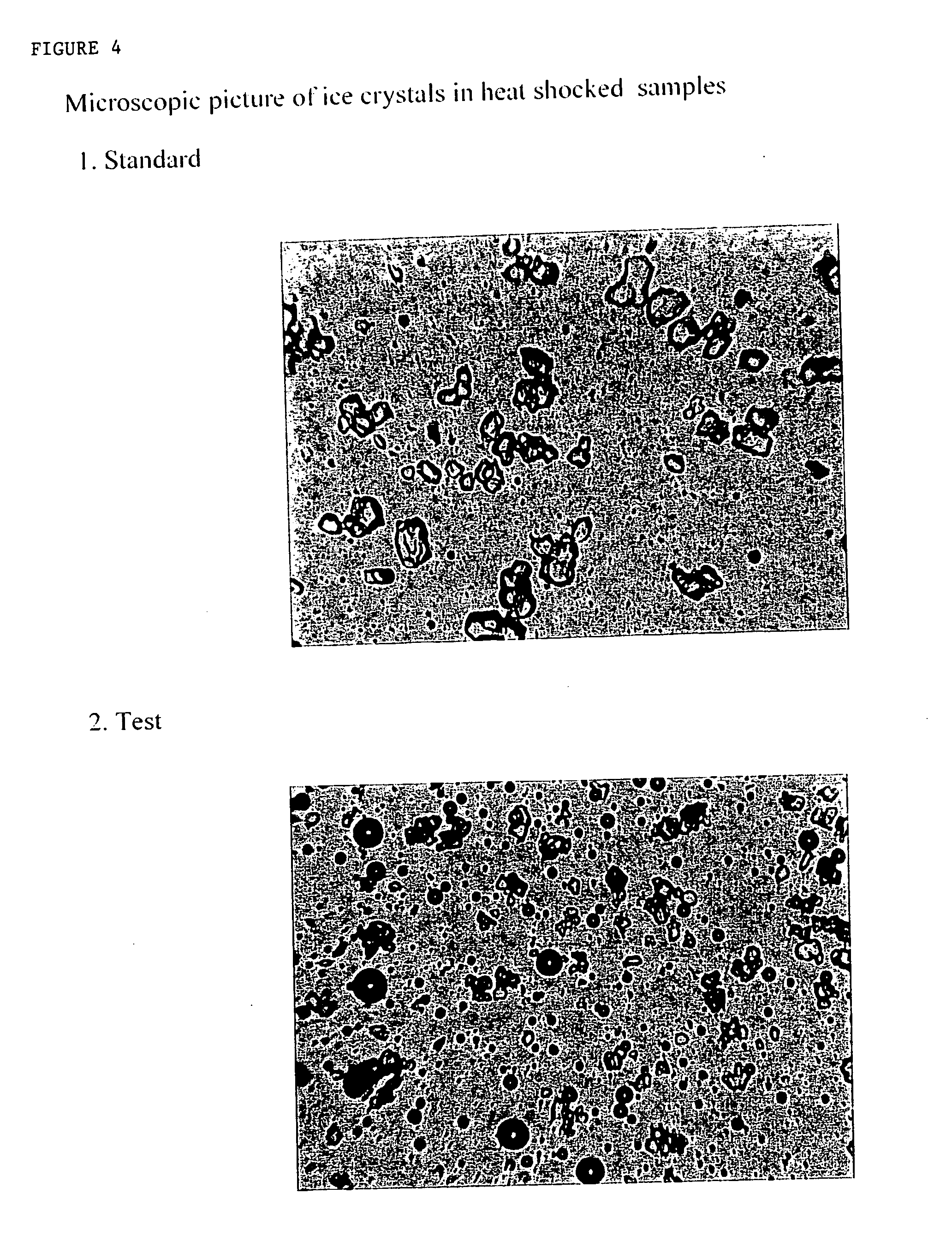Aerated frozen products
a technology of frozen confections and molded aerated bars, which is applied in the field of aerated frozen confections, can solve the problems of reducing the overall quality of frozen confections as perceived by consumers, unsatisfactory crystallization texture of frozen confectionery, and the process of manufacturing molded aerated frozen bars, etc., and achieves the effect of favorable textur
- Summary
- Abstract
- Description
- Claims
- Application Information
AI Technical Summary
Benefits of technology
Problems solved by technology
Method used
Image
Examples
example 1
[0065] An ice cream mix was prepared from 8% (by weight) partially hydrogenated palm kernel oil, 11% nonfat milk solids, 12% sucrose, 6% corn syrup solids (36DE) and 0.5% of a stabilizer blend containing combinations of hydrocolloids such as guar, locust bean gum, carrageenan, carboxymethyl cellulose, etc. together with emulsifiers. The ingredients were mixed with agitation to disperse and solubilize them into a homogeneous mass, homogenized with a two stage homogenizer at 2000 psig pressure at the first stage and 500 psig pressure at the second stage, followed by HTST pasteurization.
[0066] After pasteurization, the mix was aged by refrigerated storage at a temperature of 4° C. for 6 hours. The aged mix was colored, flavored, and then aerated in an Oakes Mixer at a temperature of 4° C. to an overrun of 130%.
[0067] The aerated mix was pumped to a mold and allowed to freeze to give the frozen molded bar. The freezing was allowed to take place quiescently at a temperature of −40° C. ...
example 2
[0069] A water ice mix was prepared from 23% (by weight) sucrose, 7% corn syrup solids (36 DE) and 0.6% stabilizer blend containing combinations of hydrocolloids, such as guar, locust bean gum, pectin, carboxymethyl cellulose, gelatin, microcrystalline cellulose, hydrolyzed soy or milk proteins, etc. with or without emulsifiers. The ingredients were mixed with agitation to disperse and solubilize them into a homogeneous mass in water, homogenized with a two stage homogenizer at 1500 psig pressure at the first stage and 500 psig pressure at the second stage, followed by HTST pasteurization.
[0070] After pasteurization, the mix was aged by refrigerated storage at a temperature of 4° C. for 6 hours. The aged mix was colored, flavored, acidified (e.g. adding citric acid solution), and then aerated in an Oakes Mixer at a temperature of 4° C. to an overrun of 100%.
[0071] The aerated mix was then pumped to a mold and then allowed to freeze to give the frozen molded bar. The freezing was a...
example 3
[0073] An ice cream was prepared using the ingredients described in Table I using a conventional freezer. The ice cream product had an overrun of 120%. The draw temperature at the freezer outlet was constant at −6° C. After whipping the ice cream in a freezer, the product was placed into containers, conventionally hardened, and stored at −30° C.
TABLE IPercent CompositionIngredientsConventionalNewFat1010Non-fat milk solids7.57.5Whey solids2.52.5Sugar12.512.5Corn syrup solids, 36 DE4.54.5Guar0.150.15CMC0.050.05Carrageenan0.020.02Mono-diglycerides or monoglycerides0.30—Propylene glycol monostearate—0.3Sorbitan tristearate—0.03Unsaturated monoglycerides—0.05Water62.562.4Total solids37.537.6
[0074] To compare heat shock resistance, ice cream products made according to the present invention and using conventional methods were tested. Both types of ice cream products were treated to heat shock, as described above, or alternatively for 6 days at −8° C. Ice crystals, air bubble size and sen...
PUM
 Login to View More
Login to View More Abstract
Description
Claims
Application Information
 Login to View More
Login to View More - R&D
- Intellectual Property
- Life Sciences
- Materials
- Tech Scout
- Unparalleled Data Quality
- Higher Quality Content
- 60% Fewer Hallucinations
Browse by: Latest US Patents, China's latest patents, Technical Efficacy Thesaurus, Application Domain, Technology Topic, Popular Technical Reports.
© 2025 PatSnap. All rights reserved.Legal|Privacy policy|Modern Slavery Act Transparency Statement|Sitemap|About US| Contact US: help@patsnap.com



